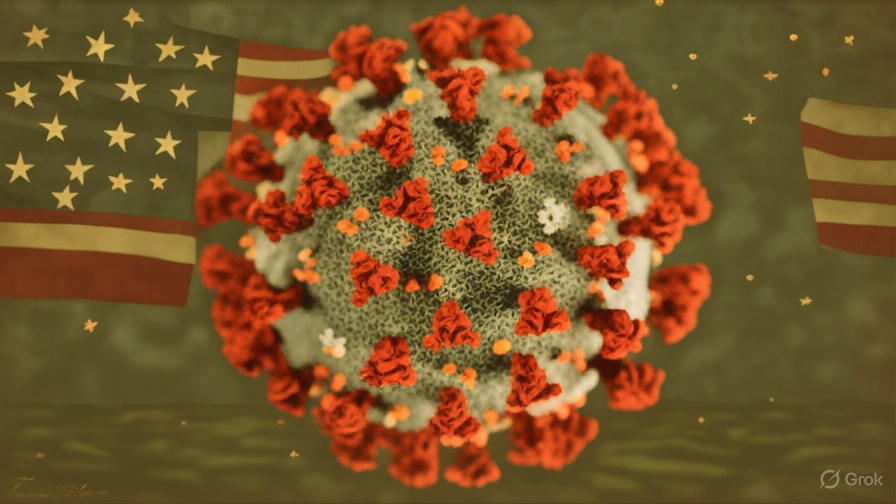New COVID-19 ‘Stratus’ Variant Fuels US Infections — What We Know So Far
Introduction
A new and highly transmissible COVID-19 strain, called XFG or “Stratus,” is gaining ground across the United States. Health experts are monitoring it closely as autumn’s respiratory virus season begins. The variant’s spread — already reported in 38 countries — has sparked public concern and debate, partly amplified by viral posts on social media.
This report breaks down the key facts about Stratus, its symptoms, what experts advise, and the broader implications for public health.
New, highly transmissible COVID-19 strain fueling wave of infections across US https://t.co/5gzkF64JnD pic.twitter.com/DCNcD3v36C
— New York Post (@nypost) October 2, 2025
The Stratus (XFG) Variant at a Glance
- Origin: First detected in Southeast Asia in January 2025.
- US Arrival: Identified in spring 2025.
- Spread: Present in 38 countries by June 2025.
- Classification: Labeled by the World Health Organization (WHO) as a “variant under monitoring.”
- Dominance: Recently overtook the previous Omicron sub-strain NB.1.8.1 (“Nimbus”) in the US.
Symptoms and Clinical Profile
While most infections remain mild in vaccinated individuals, Stratus shows distinct patterns:
- Hoarseness and scratchy or sore throat — sometimes mistaken for seasonal allergies.
- Similar but slightly less severe throat pain than the “razor-blade” sore throat often caused by the earlier Nimbus variant.
- Experts emphasize that vaccination still offers strong protection against severe disease.
Current Spread in the US
According to the CDC wastewater monitoring report (Sept 20, 2025):
- Overall viral activity is at a moderate national level.
- 19 states, including Nevada, Utah, Connecticut, and Delaware, show “high” or “very high” wastewater levels of COVID-19.
- The surge coincides with the seasonal rise in other respiratory viruses such as flu and RSV.
Expert Guidance and Preventive Steps
Specialists stress that the public can reduce risk by taking simple, evidence-based precautions:
- Vaccination: The CDC’s Advisory Committee on Immunization Practices (ACIP) recommends the 2025-26 updated COVID-19 vaccines for everyone 6 months and older after professional consultation.
- Stay Home if Sick: Avoiding contact while symptomatic helps prevent spread.
- Hygiene: Regular hand-washing and mask use in crowded indoor spaces remain effective.
- Air Quality: Improving ventilation and filtration indoors is encouraged, particularly in schools and workplaces.
Public Reaction and Misinformation
The viral New York Post tweet sharing this news gathered 77,000+ views but also heavy skepticism:
- Many replies dismissed it as seasonal colds or “fearmongering.”
- Public health officials warn that underestimating new variants can delay protective measures.
- Experts urge reliance on official health agency updates instead of unverified social-media commentary.
FAQs
Q1. Is the Stratus variant more dangerous than previous strains?
Current data suggest no higher severity, but its higher transmissibility and immune-evasive traits can still lead to significant case surges, especially in undervaccinated areas.
Q2. Do vaccines still work against Stratus?
Yes. Updated 2025-26 COVID-19 vaccines remain effective at reducing severe disease and hospitalization.
Q3. Should I get tested for mild sore throat or allergy-like symptoms?
If symptoms persist or worsen — particularly if you’re at higher risk or live with vulnerable people — testing is recommended.
Q4. How can I protect my household during this season?
Keep vaccinations up-to-date, stay home if sick, ventilate indoor spaces, and maintain good hygiene.
Q5. Will Stratus trigger new lockdowns?
Health authorities have not indicated plans for lockdowns. Current strategies focus on vaccination and personal preventive measures.
Conclusion
The emergence of the Stratus (XFG) COVID-19 variant highlights the ongoing evolution of the virus. While most cases appear mild — particularly among the vaccinated — the variant’s spread coincides with seasonal respiratory illnesses, making vigilance and timely vaccination essential.
Public health experts stress that preparedness and practical precautions, not panic, are the right approach.
Opinion
Beyond the immediate headlines, Stratus underscores the enduring challenge of living with a mutating respiratory virus. Societies face a balancing act: maintaining daily life and economic activity while responding nimbly to changing viral dynamics.
Mistrust of institutions and fatigue from previous pandemic waves have created an environment where public messaging competes with online skepticism and misinformation. For many, the debate is less about the virus itself and more about how governments, media, and health authorities communicate risk and enforce policies.
The reality is that viruses adapt; human responses must adapt too. This variant will likely not be the last — and the key question is whether communities can learn to sustain proactive, science-driven measures without swinging between fear and complacency.
Understanding that tension — between data-driven caution and the public’s desire for normalcy — may be as critical as tracking the virus’s genetic shifts.


0 comments